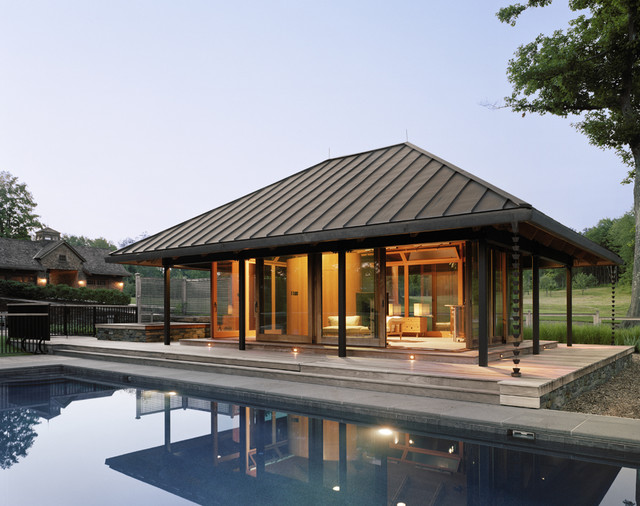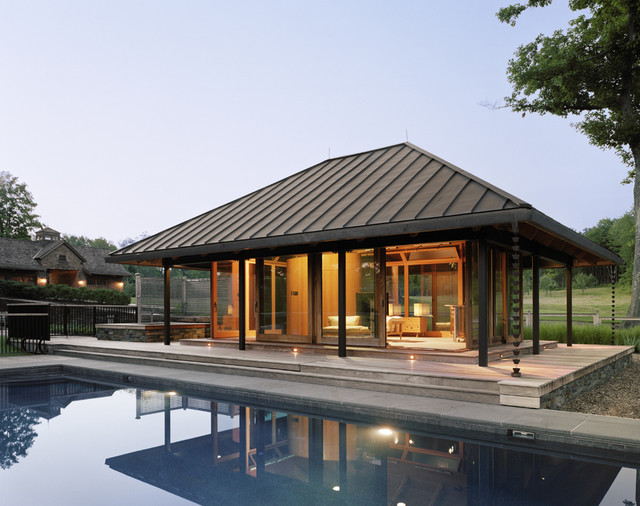
The Top 7 Best And Most Useful Types Of Roofs
Gable Roofs
Firstly, gable roofs are one of the most common types of roofs in colder climates. It consists of two sections whose upper horizontal edges meet to form its ridge. In regions with strong winds and heavy rain, gable roofs are built with a steep pitch in order to present to prevent the ingress of water.
They are recognised by their triangular shape.
Gable roofs are friendly to all types of materials. However, if they contain hips and valleys, consider using metal shingles or standing seams to avoid leaks.
Advantages:
- Inexpesnive
- Are based on simple design principle
- More weather-resistant than flat roofs
- The loft can be turned into living space
Disadvantages:
- Gable roofs are more prone to wind damage than hip roofs
- Gable roofs can collapse if frames are not constructed properly
Mansard roof
Secondly, A mansard roof is a four-sided gambrel-style hip roof. It has two slopes on each side. Punctured by dormer windows, at a steeper angle than the upper. This type of roof with windows creates additional floor and living space.
Pros:
- The mansard style makes maximum use of the interior space of the loft
- A simple mansard roof is rather cheap
- Extra living space adds value to the house
Cons
- A typical mansard can be costly
- A low pitched mansard roof is not recommended for use in places with high rainfall

Hip roofs
Thirdly, a hip roof is a type of roof where all sides slope downwards to the walls. They usually have four sides like a mansard roof, often shaped like a pyramid. There are three types of hip roofs: simple hip, crossed hip, and half-hipped. However, simple hip roofs are the most common.
Pros:
- Durable and sturdy
- It is excellent for windy areas
- Offers extra living space
Cons:
- Expensive and complex
- Can develop water leaks if not well installed
- Requires extra maintenance
Shed roof
A shed roof is a single sloping roof attached to a taller wall. A shed roof doesn’t have any adjoining roofs. And can be installed on an independent building or leaned into an already existing one.
They are mostly used for home additions and are getting popular with modern home roofing. This roof is used for eco-friendly houses.
Pros:
- Suitable for rain regions
- Less expensive
- Allows natural light
- Easy to assemble
Cons:
- When the pitch is too high, the ceiling becomes low.
- Not suitable for areas with high wind

Gambrel roof
A gambrel roof has two different slopes, one side is almost vertical steep slope while the other slope is lower. This design provides the advantages of a sloped roof while maximising headroom inside the building’s upper level. Gambrel roofs are also getting popular in modern builds.
Pros
- It allows extra living space
- Easy construction
- Less expesnice
- Provides more storage
cons
- Regular maintenance
- Needs to be water proof at the ridges
- Not usefull in high wind areas
- Windows may increase the chances of leaks

Flat roof
Flat roofs are often not 100% flat, there is a slight slope that allows water to run off. They also have centrally located drains and gutters to get rid of the rainwater on top of the roof. Flat roofs are common to commercial and industrial buildings. Flat roofs are often used in warmer climates, which allows the roof space to be used as a living space.
Pros:
- Less expensive to construct
- Suitable for installing solar panals when constructing an eco friendly house
Cons:
- Not suitable for high rainfall areas
- Frequent maintence and repairs
Bonnet roof
Finally, bonnet roofs are like a reverse mansard roof. They have double slopes, the lower slopes are at a lesser angle than the upper slopes. In addition, if you have an open porch the lower slopes are good because they overhang and create a cover.
Pros:
- They allow dormers
- Overhanging eaves provide protection from water damage
- Durable
- Bonnet roof allows extra living spac for a small loft
Cons:
- Difficult to construct
- More expensive
- Need complex materials






